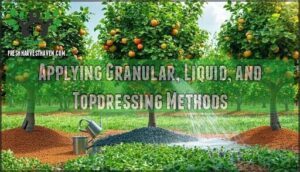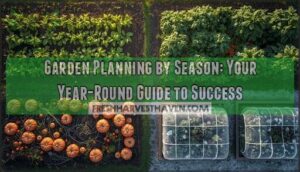This site is supported by our readers. We may earn a commission, at no cost to you, if you purchase through links.

Apply fertilizer in early spring before buds break, calculating amounts based on trunk diameter and nutrient content. Spread granular fertilizer evenly under the canopy, avoiding direct contact with the trunk, or use liquid applications for quicker uptake. Timing matters—late-season feeding can trigger soft growth vulnerable to winter damage.
Organic options like compost release nitrogen gradually, building soil health alongside yields. Getting the details right transforms mediocre harvests into abundant, high-quality fruit.
Table Of Contents
- Key Takeaways
- Why Fertilizing Fruit Trees is Essential
- When and How Often to Fertilize Fruit Trees
- Choosing The Right Fertilizer for Fruit Trees
- Step-by-Step Guide to Fertilizing Fruit Trees
- Key Tips for Maintaining Healthy Fruit Trees
- Frequently Asked Questions (FAQs)
- When should I fertilize my Trees?
- When is the best time to fertilize fruit trees?
- Should you fertilize fruit trees in the winter?
- How do you fertilize fruit trees for a big harvest?
- In what month should you fertilize your fruit trees?
- How do you apply 10-10-10 fertilizer to fruit trees?
- What does Epsom salt do for fruit trees?
- How often should you fertilize a fruit tree?
- Why is fertilizing a fruit tree important?
- What fertilizer should a fruit tree use?
- Conclusion
Key Takeaways
- Start with a soil test to identify nutrient gaps and pH levels before selecting a fertilizer—young trees thrive on balanced 10-10-10 formulas, while mature fruiting trees need potassium-rich blends like 8-8-16 to maximize yield and fruit quality.
- Apply fertilizer in early spring before bud break when soil temperatures reach 40°F and trees actively absorb nutrients, avoiding late-season applications that trigger frost-vulnerable growth and winter injury.
- Spread granular fertilizer evenly from one foot beyond the trunk to the drip line without direct trunk contact, or use liquid applications for faster uptake—calculate amounts based on trunk diameter and actual nitrogen content in your chosen product.
- Organic options like compost and fish meal release nitrogen gradually while building long-term soil health and microbial activity, though they cost more upfront than synthetics that risk root burn and environmental runoff from overapplication.
Why Fertilizing Fruit Trees is Essential
Fertilizing your fruit trees isn’t just about feeding them—it’s about unlocking their full potential. Understanding why proper nutrition matters will help you make better decisions throughout the growing season.
Boosting Fruit Yield and Quality
Feed your fruit trees the right nutrients at the right time, and you’ll be harvesting fruit that rivals anything at the farmers’ market.
How much and when you fertilize directly impacts what you pick:
- Fruit size and sweetness boost improve dramatically when trees receive balanced nutrition during critical growth phases
- Color development intensifies as adequate potassium and micronutrients foster pigment formation
- Extended harvest periods result from consistent fertilizing fruit trees, sustaining fruit tree growth and health throughout the season while boosting pest resistance
Preventing Nutrient Deficiencies
You won’t see a single healthy fruit hanging from branches riddled with yellowing leaves, stunted shoots, or bark that’s started to crack—telltale signs your tree is starving for specific nutrients it can’t pull from depleted soil.
A soil test reveals which essential nutrients are missing, allowing you to implement corrective measures through targeted nutrient management.
Visual deficiency signs—like chlorotic foliage or poor fruit set—demand immediate micronutrient supplementation, while annual soil nutrient analysis ensures long-term prevention of these productivity-limiting conditions.
Enhancing Tree Health and Disease Resistance
Trees fed the right nutrients develop stronger natural defenses against fungal infections, bacterial diseases, and pests that target weaker specimens.
Keeping nutrients in balance reinforces cell walls and boosts disease resistance, while adding calcium helps prevent disorders that can undermine overall tree health.
When you combine smart fertilization with regular pruning and keeping an eye on your soil, you’re building fruit trees that can naturally fight off diseases and pests—no need to rely heavily on chemical sprays.
When and How Often to Fertilize Fruit Trees
Timing your fertilizer applications correctly makes the difference between a thriving orchard and one that struggles.
Here’s what you need to know about when to feed your trees and how often they actually need it.
Best Time of Year for Fertilizing
When you fertilize matters as much as what you use. The goal is matching nutrient delivery to your tree’s growth cycles—that’s how you maximize both health and yield.
Spring fertilization—ideally early spring before bud break—aids active root growth and canopy development as trees emerge from dormancy.
Fall applications with slow-release formulas can work in milder climates, letting roots absorb nutrients during their winter growth cycle, though regional variations and climate impact dictate when not to fertilize to avoid frost-tender growth.
How Tree Age and Type Affect Timing
A young sapling demands a different feeding schedule than a mature producer, and fruit type—whether stone fruit or pome—adds another layer to the timing equation.
Young trees require lighter, more frequent applications during their first three years to foster root establishment without forcing excessive top growth.
Mature tree needs shift toward heavier dormant season boosts, while stone fruits usually need fertilizer application rates adjusted earlier than pome fruits due to their accelerated spring flush.
When Not to Fertilize Certain Fruits
Skipping fertilizer altogether sounds counterintuitive, but June-bearing strawberries in spring and certain established fruits under specific conditions actually thrive when you hold back the nutrients.
Spring strawberry caution prevents excess foliage that invites disease before budbreak, while established tree risks include winter injury from late-season nitrogen pushing tender growth vulnerable to frost.
Watch for over-fertilization signs—dark leaves and weak wood—especially during the dormant season when avoiding imbalance issues matters most for fruit maturity.
Choosing The Right Fertilizer for Fruit Trees
Selecting the right fertilizer starts with understanding what your soil already contains and what your trees actually need.
Consider the nutrient balance, decide between organic and synthetic options, and remember that different fruit trees have distinct needs.
Understanding NPK Ratios and Soil Needs
NPK ratios work like a nutritional label for your trees. Nitrogen powers leaf production, phosphorus supports flowering and strong roots, and potassium boosts fruit quality.
To know what your soil already has, testing shows both nutrient levels and pH—most fruit trees do best between 6.0 and 6.5 for nutrient absorption.
Young trees benefit from balanced 10-10-10 formulas, while mature fruiting trees need potassium-rich ratios like 8-8-16 to increase yield without excessive foliage. Regular monitoring of soil nutrient levels is vital for maintaining ideal tree health.
Organic Vs. Synthetic Fertilizer Options
Your choice between organic fertilizer and synthetic options shapes everything from soil microbiology to long-term tree vitality. Organic fertilizers like compost, fish meal, and kelp release nitrogen gradually, boosting yields by 15–20% while cutting greenhouse gas emissions by 29%. Synthetics deliver nutrients rapidly but risk root burn and leaching—only 35% of applied nitrogen actually reaches your trees.
Here’s what matters when fertilizing fruit trees:
- Soil test results guide fertilizer application rates and reveal existing nutrient gaps
- Organic benefits include amplified microbial activity and improved water retention
- Synthetic risks involve nitrate accumulation and potential environmental runoff
- Fertilizer costs run higher for organics, though sustainability premiums offset expenses
- Environmental impact favors organics through reduced contamination and better nitrogen use efficiency
Understanding the differences between soil health options is vital for making informed decisions about fertilizer application.
Run a soil test before committing to either approach—you’ll avoid overapplication and protect your investment.
Fruit-Specific Fertilizer Recommendations
Fruit tree fertilization demands customized soil amendments for ideal crop yields. Apple and peach trees respond best to balanced 10-10-10 fertilizers, with 8 oz calcium nitrate applied per young tree annually, never exceeding 1 lb nitrogen total.
Citrus thrives on high-nitrogen blends like 7-4-6, while stone fruits need careful timing to avoid over-fertilization during fruiting.
Dragon fruit requires variety-specific NPK ratios: white-pulp cultivars need 400g N, 300g P₂O₅, and 650g K₂O per pillar, boosting yields 55% over standard practices.
Match fertilizer types to your tree’s biology for peak fruit nutrition.
Step-by-Step Guide to Fertilizing Fruit Trees
Applying fertilizer correctly ensures your trees get the nutrients they need without waste or root damage.
Here’s how to figure out the right amounts and pick an application method that works for you.
Calculating Fertilizer Amounts
Figuring out how much fertilizer to apply comes down to a simple math problem using your tree’s trunk diameter and the nitrogen percentage in your fertilizer. Measure the trunk diameter about a foot above the ground, then multiply that number by 0.1—that’s how many pounds of actual nitrogen your tree needs each year.
Using a 10-10-10 fertilizer? You’ll need ten times that amount, since only 10% of it is nitrogen.
A soil test beforehand ensures you’re addressing actual nutrient levels rather than oversupplying what’s already present.
Applying Granular, Liquid, and Topdressing Methods
Once you’ve calculated the right amount, the method you choose—granular, liquid, or topdressing—depends on how quickly you want nutrients available and how your tree’s roots are distributed.
Here’s how each technique works for fertilizing fruit trees:
- Applying granular fertilizer: Spread fertilizer blends evenly beneath the drip line using granule spreading techniques, then water thoroughly for soil drenching.
- Applying liquid fertilizer: Dilute according to package directions and apply via foliar feeding or root zone soil drenching for immediate nutrient uptake.
- Topdressing fruit trees: Scatter compost or slow-release topdress applications around the base, keeping materials away from the trunk to prevent rot.
Key Tips for Maintaining Healthy Fruit Trees
Fertilizing your fruit trees is only part of the equation—keeping them healthy year after year requires consistent care and attention.
Here are a few essential practices that’ll help you maintain vigorous growth, prevent problems before they start, and guarantee your trees stay productive for seasons to come.
Annual Maintenance and Pruning
Your fruit trees need steady attention throughout the year—think of fertilization, pruning, and upkeep as non-negotiable habits.
An annual trim keeps trees shapely and encourages better fruiting. Loosening compacted soil feeds roots and boosts fertility.
Early training steers young limbs in the right direction, and thinning the crop prevents branches from snapping under weight while giving you bigger, better fruit.
| Maintenance Task | Timing and Purpose |
|---|---|
| Pruning Techniques | Late winter/early spring to remove dead wood and shape structure |
| Fruit Thinning | Early summer to reduce crop load and improve fruit size |
| Soil Aeration | Spring or fall to improve drainage and root oxygen uptake |
| Tree Training | First 3-5 years to establish strong scaffold branches |
| Winter Protection | Late fall to shield trunks from frost cracking and rodent damage |
Regular lawn fertilization near your trees may reduce the need for separate applications when fertilizing fruit trees. This integrated approach bolsters fruit tree growth and overall tree health while maintaining ideal soil conditions for long-term productivity.
Monitoring Soil and Tree Health
Beyond the work of pruning and fertilizing, you’ll want to keep a steady eye on what’s happening below ground and within the canopy itself. Soil testing every three years gives you hard data on soil pH, soil fertility, and nutrient levels—helping you catch problems before they show up as yellowing leaves or stunted growth. Foliar sampling at 60–70 days after petal fall tracks nitrogen, phosphorus, and other essentials with precision, while soil moisture monitoring reveals when irrigation timing needs adjustment.
- Collect soil samples from two depths (0–6 in. and 6–12 in.) across your orchard to assess soil quality and nutrient availability
- Use leaf tissue analysis annually to confirm your tree health and guide fertilizer adjustments based on actual uptake
- Monitor soil moisture with tensiometers or capacitance probes, since trees can lose over 40% of photosynthetic capacity before visual stress appears
Regular tree inspection catches nutrient deficiencies early, and pairing a soil test with nutrient analysis ensures your fertilizer program matches what your trees actually need.
Adjusting Practices for Potted or Small Fruits
When your fruit trees live in containers or you’re working with strawberries, raspberries, and other small-fruit varieties, your fertilizer strategy shifts—confined root systems and faster nutrient cycling demand more frequent, lighter feeding than you’d give an orchard tree anchored in open ground.
Potting soil specifics matter: container fertilizer needs usually double because watering considerations flush nutrients through drainage holes faster. Run a soil test before fertilizing small fruits, then apply diluted organic fertilizer every 4–6 weeks during active growth, adjusting for space limitations and the unique demands of each crop.
Frequently Asked Questions (FAQs)
When should I fertilize my Trees?
Get the timing right with fertilizer schedules and tree growth stages—it makes all the difference.
You’ll want to fertilize fruit trees in early spring before new growth begins, when soil temperature reaches about 40°F and nutrient uptake accelerates, guaranteeing your trees absorb what they need for the season ahead.
When is the best time to fertilize fruit trees?
You’ll get the best results from fertilization timing when you apply nutrients in early spring, just before bud break. This seasonal application aligns with peak nutrient uptake as trees mobilize resources for growth.
A soil test beforehand ensures your fruit tree fertilization methods match actual needs.
Should you fertilize fruit trees in the winter?
Winter fertilization walks a tightrope—while tree roots continue absorbing nutrients during dormancy, late-season nitrogen applications risk stimulating new growth vulnerable to winter injury.
You can apply slow-release granular fertilizer in fall, but avoid fertilizing once soil temperature drops below 40°F, as cold climate conditions limit nutrient uptake and storage.
How do you fertilize fruit trees for a big harvest?
You’ll increase fruit production through strategic fertilizer application based on a soil test, matching nutrient absorption to tree growth stages.
Apply balanced fertilizer types in spring, tailoring fruit tree nutrition to improve harvest while preparing soil for sustained yields.
In what month should you fertilize your fruit trees?
Spring’s your window for fertilizing fruit trees. Hit them with nutrients in April or early May, right when buds start swelling but before flowers open.
This seasonal timing lets you deliver nutrients when roots actively absorb them, supporting vigorous growth and fruit production. Conduct soil testing beforehand to determine your fertilizer application needs and avoid monthly applications that stress trees.
How do you apply 10-10-10 fertilizer to fruit trees?
You’ll need to broadcast granular fertilizer evenly across the root zone—starting about a foot from the trunk and extending to the drip line.
Apply in early spring before new growth emerges, using soil pH results to guide rates and securing proper application methods for ideal nutrient uptake.
What does Epsom salt do for fruit trees?
Magnesium matters more than most growers realize. Epsom salt supplies this essential mineral, correcting deficiencies that cause yellowing leaves and poor fruit development.
You’ll apply it when soil tests reveal low magnesium levels or improper soil pH balance interferes with nutrient uptake.
How often should you fertilize a fruit tree?
You’ll normally fertilize fruit trees once annually in early spring, though fertilization schedules vary with tree growth rates and soil nutrient levels.
Soil testing for fruit trees guides fertilizer selection and application frequency—everbearing types need fertilizer twice yearly, while established trees with steady fruit production cycles may skip years if growth remains vigorous.
Why is fertilizing a fruit tree important?
Fertilizing replenishes depleted nitrogen, phosphorus, and potassium in soil, sustaining fruit growth and tree nutrition. Without balanced nutrient input, fruit trees can’t maintain plant development, leading to poor yields and compromised soil quality over time.
What fertilizer should a fruit tree use?
Your fruit trees benefit most from balanced fertilizer with equal NPK ratios like 10-10-
These can be applied through organic options such as compost or fish meal for slow-release nutrient delivery, or synthetic granular types for immediate results.
Conclusion
Learning to fertilize fruit trees properly turns your orchard into a productive ecosystem that actually delivers.
You’re basically building a nutrient highway between the soil and your trees’ canopy—when you get it right, everything flows.
Apply fertilizer at ideal times, choose formulas matched to your soil’s chemistry, and monitor your trees’ response throughout the growing season. With proper technique and attention to timing, you’ll cultivate stronger trees that reward your efforts with abundant, flavorful harvests year after year.
- https://www.canr.msu.edu/news/spring_fertilization_of_garden_fruits
- https://blogs.ifas.ufl.edu/miamidadeco/2024/05/16/fertilizing-fruit-trees/
- https://njaes.rutgers.edu/pubs/commercial-tree-fruit-guide/03-Orchard-Nutrition.pdf
- https://vlsci.com/blog/fertilizing-fruit-trees/
- https://www.marthastewart.com/how-to-fertilize-fruit-trees-11740219








